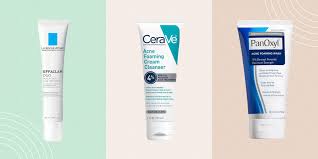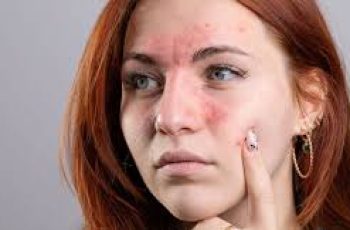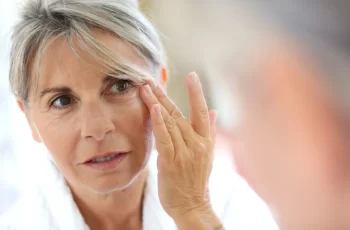
Benzoyl Peroxide in Skin care
Benzoyl peroxide (BPO) is one of the most common ingredients in over-the counter (OTC) and prescription acne treatments. (1)
Best for oily skin types, this ingredient is great for eliminating acne-causing bacteria and reducing the size of clogged pores.
Like many other cleansing and exfoliating ingredients, BPO has a low pH and aids in desquamation of the skin.
First studied for dermatologic use in the early 20th century, this ingredient has undergone extreme scrutiny in studies and is considered safe for many skin types.
To find out if benzoyl peroxide is right for your skin type and skin concerns, read below to get the facts on this interesting ingredient, and take our quiz to find the perfect dermatologist recommended skin care regimen for you!
What is benzoyl peroxide?
It’s a carbonyl compound, a classification of chemicals known for having oxygen atoms double bonded to carbon atoms.
It is acidic, meaning it can be considered a low pH cleanser. This means it will affect other products in your skin care routine. Make sure you understand how different pH’s interact in skin care products.
BPO was originally extracted from a larger compound called chlorohydroxyquinoline (3), which comes from different kinds of tar.
Today, BPO is synthesized more efficiently by combining hydrogen peroxide with benzoyl chloride.
The chemical formula of BPO is [C6H5C(O)]2O2. This chemical is made of two benzoyl groups bound together by peroxide. (3,53)
It is lipophilic, meaning it is soluble in fats and is able to penetrate through sebum on your face unlike alpha hydroxy acids like glycolic acid.
Here are some of my favorite products with Benzoyl Peroxide:
How does it work?
Since benzoyl peroxide is lipophilic, it is able to easily penetrate past the outermost layers of the skin without modifications. (15)
Lipophilic acids like benzoyl peroxide or salicylic acid are able to essentially pass through the oils in clogged pores while exfoliating the surfaces of those pores. (3)
In addition, the low pH environment and reactive oxygen ions produced by BPO eliminate acne-causing and other bacteria on the skin. (18)
Specifically, BPO releases reactive oxygen ions that rip apart bacteria membranes. This is why BP is considered antimicrobial.
The primary use of BPO, for those reasons, is in acne creams, gels, lotions, serums, and cleansers.
BPO causes exfoliation through its low pH; as an acid it breaks down the connective membranes between dead or inflamed skin and healthy skin.
Exfoliating assists in your bodies natural desquamation processes.
The primary mechanisms for the function of benzoyl peroxide in skin care can be traced back to its fat solubility, low pH, and antimicrobial properties.
Structure
Benzoyl peroxide structure
Benefits
Benzoyl peroxide is considered one of the most effective antimicrobial exfoliating ingredients in skin care for most oily skin types.
The original most common use for BPO was as a burn or wound treatment in the early 20th century. (5)
Studies have found that using BPO decreases antibiotic resistance. (14,15)
Because of its ability to reduce clogged pores and block the acne cycle it is sometimes called anti-inflammatory,(26) however, it does not act on the inflammatory cycle, but rather helps prevent skin from getting inflamed by unclogging pores and reducing bacteria.
It is neither a humectant nor does it contain any hydrating fatty acids and can be very drying to the skin. This is why it is better for oily skin types.
It is an exfoliating ingredient. Exfoliators assist in the removal of dead skin cells from the face which triggers the skin to produce more skin cells and collagen.
If you have oily, acne prone skin, benzoyl peroxide might be a good choice for your skin care routine!
Benzoyl Peroxide side-effects
Side-effects and Risks
Even though benzoyl peroxide is extremely effective in treating acne, it has a few side-effects that keep it from being good for everyone.
It is particularly difficult for dry skin types to tolerate.
Can benzoyl peroxide cause a skin allergy?
Benzoyl peroxide is considered an insignificant allergen, so it does not cause true immune system mediated allergy.
However BPO is considered an irritant on the skin, especially in high concentrations such as 5% and 10%. This means that redness, stinging, or peeling can result from overuse. In fact, skin reactions to benzoyl peroxide are very common.
Studies have also found that irritation resulting from contact with BPO as either an allergic reaction or general irritant dermatitis occurs in about 1% of patients. (46,47)
Click this link if you have a reaction to benzoyl peroxide and need advice.
Does BPO cause skin cancer?
In the 90’s FDA conducted a study that determined when BPO is exposed to direct sunlight it oxidizes intensely, increasing the likelihood of skin cancer in mice. (34-41)
The study concluded this could have been the case because benzoyl peroxide releases reactive oxygen ions, also called free radicals, that can intensify free radical presence on the skin. It’s release of reactive oxygen is the same mechanism BPO exhibits to eliminate acne causing bacteria.
It is best to use BPO in a rinse off cleanser or at night to avoid this issue. If you use BPO in the daytime, make sure you apply SPF.
Does BPO cause skin aging?
It is possible that BPO can cause skin aging because it triggers free radicals. To avoid this, use rinse off BPO such as in cleansers, followed by an antioxidant, and avoid wearing BPO in the sun.
Is it safe? Is it a clean ingredient?
Even though benzoyl peroxide has a number of notable side-effects and usage considerations, the concentrations available in over the counter skin care products are considered safe.
The Cosmetic Ingredient Review panel has studied this ingredient extensively, and has deemed it safe for use.
In 2011, the FDA officially categorized benzoyl peroxide as “GREASE” (Generally Recognized As Safe and Effective). (42)
This determination takes into consideration the oxidizing and irritating properties of benzoyl peroxide, but recognizes that there are uses where these concerns are not relevant.
Studies have found that benzoyl peroxide is a safe treatment for acne during pregnancy. (15,43-45)
The EWG rates benzoyl peroxide as a 3, which means they have safety concerns.
It is not allowed in some “clean” skin care products because some standards do not consider it a clean ingredient.
However, BP is one of the best ways to eradicate acne-causing bacteria without making the bacteria resistant to antibiotics- so the benefits of BPO outweigh the risks where personal health and the environment are concerns.
If you have oily, acne prone skin that is not particularly sensitive to irritation, and you don’t plan on long term sun exposure shortly after applying BPO, it could be a great addition for your acne routine!
If you have dry skin or easily irritated hypersensitive skin, BPO might be difficult for you to tolerate.
Benzoyl peroxide vs salicylic acid
Benzoyl peroxide vs salicylic acid
Salicylic acid is a beta hydroxy acid commonly used in chemical peels for oily skin types.
Like Benzoyl Peroxide, salicylic acid is lipophilic and reduces pores in part by removing oil from the skin.
Unlike Benzoyl Peroxide, salicylic acid does not pose major risks associated with oxidization or free radical production on the skin.
Both ingredients are of low pH, i.e., they’re acidic.
BPO is primarily used for its potent antimicrobial and anti-acne benefits, while salicylic acid is primarily used in exfoliating, peeling, or cleansing products.
Unlike salicylic acid, BPO is not good for use in anti-aging regimens.
Salicylic acid is more acidic, meaning it is better used for infrequent treatments like peels, while benzoyl peroxide is useful in daily acne spot treatments.
Salicylic acid can soothe redness, while benzoyl peroxide can be irritating.
Uses
Benzoyl peroxide is most commonly found in acne treatment products that range from cleansers to exfoliators, serums, and gels.
Because it is such a common irritant to skin, using a barrier repair moisturizer alongside BPO is common to reduce side-effects in dry skin types.
BPO aids in desquamation of the skin, so if you use it with other exfoliating products, you increase your risk of irritation.
To find out what kinds of benzoyl peroxide products might be right for your Baumann Skin Type, take our quiz and get a dermatologist recommended custom regimen today!
Take the Quiz
Acne
Benzoyl peroxide is one of the most effective ingredients for treatments of acne in oily skin types.
Due to its potency, some of the most effective BPO acne products are available by prescription only, though over the counter products have demonstrated great effects in studies as well. (2)
The mechanism BPO uses to eliminate acne causing bacteria is relatively unique in that it causes oxidization of bacterial cell membranes. (18)
It’s manner of reducing clogged pores is similar to salicylic acid’s; it absorbs sebum from the skin while exfoliating surface level obstructions, aiding in desquamation. (26)
It is non-comedogenic and in fact it helps get rid of blackheads and whiteheads.
Studies have found that BPO increases the efficacy of combined antimicrobial ingredients. (27)
Overall, if you have oily, acne prone skin, benzoyl peroxide might be a great addition to your acne routine.
Sensitive skin
If you have sensitive skin prone to stinging, you should probably avoid benzoyl peroxide.
Benzoyl peroxide is considered an irritant even to resistant skin types, so unless you have oily skin, it might be best to find less irritating acne treatments for your personal routine.
Unlike many other chemical peel ingredients or acne treatments like hydroxy acids, BPO does not have any moisturizing or anti-irritating properties.
Anti-aging
Unlike some other low pH ingredients, benzoyl peroxide is not considered effective for anti-aging or wrinkle reducing treatments.
The reason it is not optimal for those treatments is because of its tendency to oxidize in response to sunlight. (48)
Free radicals that result from oxidization can cause long term damage and increase risks of skin aging and cancer. (48)
If you are looking for a cleansing ingredient to include in your anti-aging regimen, BPO is not the right ingredient for you.
dry skin types should not use benzoyl peroxide
Dry skin
Benzoyl peroxide is not recommended for use in dry skin types because it absorbs oils from the skin and causes dryness.
If you have dry skin, you should consider using other acne treatments or at least avoid using BP stronger than 2.5%.
The best acne treatments for dry skin types are made of hydrophilic, or water soluble ingredients like glycolic acid which do reduce clogged pores without stripping sebum from the skin.
Use of benzoyl peroxide on dry skin types can result in damage to the skin barrier.


